#Bahnaric
Text
Insight into Stieng [stiə̯ŋ]
What is the language called in English and the language itself?
– The language is called Stieng in English and Xtiêng or ស្ទៀង in the language itself.
– It is spoken in a mountainous area with highlands and lowlands, which led to dialects being not mutually intelligible. The main dialects are Bulo (lowland) and Bu Deh (highland). Bulo Stieng is the most highly researched dialect.
Where is the language spoken?
– It is spoken by the Stieng people of Southern Vietnam and Cambodia. Below shows a map of where Bulo Stieng speakers are located.
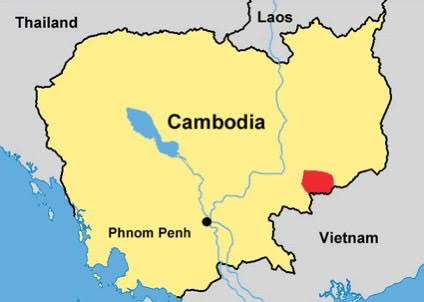
[Image description: a screenshot of a map of Cambodia with a small section in the central East highlighted in red to denote where Bulo speakers reside. /End ID]
How many people speak the language?
– As of 2009, there are 90,000 speakers of Stieng.
Which language family does it belong to? What are some of its relative languages?
– It is classified as Austroasiatic > Bahnaric > Southern > Stieng. It’s closest relative languages are Chrau and Mnong.
What writing system does the language use?
– Stieng is written in the Latin and Khmer scripts.
– Sample text from Miller (1976): Bu dơp coon jhú, pơm oh. | Hêy dhot pi sôw ô jong doom. | Toh phao bon-hông mơt. | Hêy bơn-hông mơt, bu mơl phao. | Oh gêq bơn-hông mơt, sau têêp bơlap
What kind of grammatical features does the language have?
– Stieng is an SVO language with 2 numbers, 3 persons, and at least 2 voices. It has, particles, classifiers, and a complicated kinship system. It has a tendency towards (though not strictly) monosyllabic words, long-short vowel distinction, and a lack of voice quality or tones. It also demonstrates reduplication, semantic pairings, and bitransitivity. There are also remnants of cases; however, this has not been thoroughly studied.
What does the language sound like?
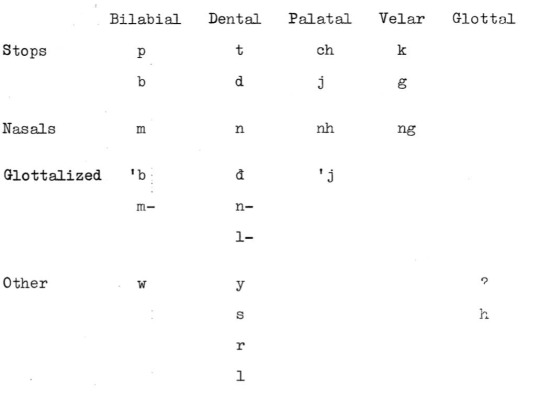
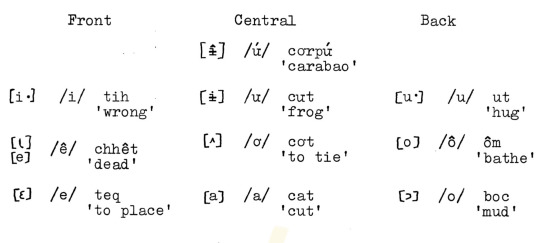

What do you personally find interesting about the language?
– I honestly like comparing and contrasting it with Vietnamese.
5 notes
·
View notes
Text
0 notes
Text

Gia Lai - điểm tới mới nhất lôi cuốn của Tây Nguyên
Giám đốc Sở Văn hóa truyền thống, Thể thao và Du lịch Gia Lai Trần Ngọc Nhung cho biết thêm thông tin, du ngoạn Gia Lai đang với những dữ thế chủ động trong những việc bình phục hoạt động giải trí du ngoạn trải qua tổ chức triển khai sự khiếu nại văn hóa truyền thống, thể thao, du ngoạn cùng với quy tế bào cả nước, cấp cho tỉnh và thị trấn. Đặc trưng, tỉnh đang tổ chức triển khai thành công xuất sắc Tuần lễ cụm sự khiếu nại xin chào 90 năm Ngày thiết kế tỉnh (24/5/1932 - 24/5/2022) với khá nhiều hoạt động giải trí ý nghĩa sâu sắc như: lễ tiếp nhận và công cha bởi xếp thứ hạng di tích lịch sử nước nhà đặc biệt quan trọng Quần thể di tích lịch sử Tây Đánh Thượng đạo, di tích lịch sử khảo cổ nước nhà Rộc Tưng-Gò Đá, Khu dự trữ sinh quyển toàn cầu cao nguyên trung bộ Kon Hà Nừng… Những hoạt động sinh hoạt ra mắt tức thì sau Lúc du ngoạn mở cửa ngõ đang tạo nên cảm giác tích rất cùng với thị ngôi trường này. Không chỉ giải lan lời xin vui đùa, tiêu khiển của những người dân nhưng cam kết Gia Lai là vấn đề tới bình yên cùng với quý khách trong nước và quốc tế. Nhiều thương hiệu trao đến di tích văn hóa truyền thống, thiên nhiên tự nhiên cũng đem tới những xúc cảm mới nhất mẻ vào thưởng thức nhiều loại hình du ngoạn. Tuần lễ hoa dã quỳ-núi lửa Chư Đang được Ya năm 2022 thú vị đông cù lao quý khách tới tham quan tiền “Cồng chiêng cuối tuần-thưởng thức và trải nghiệm” ra mắt trên Quảng ngôi trường Đại Đoàn Kết (TP. Pleiku) vào hằng ngày lễ và sự khiếu nại rộng lớn của tỉnh vào năm 2022 cũng tạo nên lốt bấm riêng biệt vào hình ảnh du ngoạn. Không chỉ tiếp thị, tôn vinh độ quý hiếm của di tích văn hóa truyền thống toàn cầu, cụm nghệ nhân Jrai, Bahnar chỉ dẫn đến quý khách thưởng thức sinh hoạt cồng...
63b76f160c76d【#ximmacao】
0 notes
Text
The State History Kon Tum Travel Guide for Everyone on a Budget

Kon Tum is a town in the Central Highlands region of Vietnam. It is the capital of Kon Tum Province, and is the administrative, economic and cultural centre of the region.
The town is located on the banks of the Dak Bla River, and is surrounded by mountains. Kon Tum has a tropical climate, with hot, humid weather all year round.
The town is home to a number of ethnic minority groups, including the Bahnar, Jarai, Ede and Vietnamese. Kon Tum is a popular tourist destination, and is known for its beautiful scenery, friendly people and rich culture.
If you're planning a trip to Kon Tum, here are a few things you should know:
Getting there: Kon Tum is located in central Vietnam, and is accessible by road, rail and air. The nearest airport is in Pleiku, which is about an hour's drive from Kon Tum.
Accommodation: There are a number of hotels and guesthouses in Kon Tum, ranging from budget to mid-range.
Things to do: Kon Tum is a great place to explore the Central Highlands region of Vietnam. There are a number of markets and shops in the town, as well as a number of temples and pagodas. Kon Tum is also home to Vietnam's largest suspension bridge, which spans the Dak Bla River.
Food: Kon Tum is famous for its beef jerky, which is a popular snack food in Vietnam. There are a number of restaurants in the town, as well as street food vendors.
When to visit: The best time to visit Kon Tum is between October and December, when the weather is cooler and the scenery is at its best.
Read the full article
0 notes
Text
"You presume to understand why your kind hate me ... shun me away and hunt me like an animal. It's not because I am wrong or evil. Quite the contrary, it is because I am the mirror that reflects their own fear and insecurity.
My art - the art of poison and pestilence - is simply a law of nature. My body is poisonous. My breath is deadly. My skin full of worms and all kinds of venomous manifestation people can imagine. But that doesn't make me a heinous existence they think I am. I simply represent to them their deepest fear and ignorance.
They can hunt me. They can torture me. They can hate me. But I will carve out a place for myself and my people. With my art and my will, they will all bow before me!"
Said by Truk Fan - Master of the Darkest Art.
---------------------------------------------
This is from my novel. It is partially inspired by Gu arts of Southern China and Northern Thailand. Gu is the magic art involving poison and many venomous creature. It is not a very well-known art in my country but I do know that some communities in Northern Thailand still practice it.
PS. Truk Fan is ENTP 8w9 so/sp (835) Double Lion and is inspired by Ong Keo, a sorcerer who led many Austroasiatic-speaking minorities (including Alak and Bahnar) against French Indochina and Siam in Holy Man's Rebellion.
Truk Fan is also an ethnic minority living deep in the isolated reach of Gmak Thuan - a mountainous coastline. His people are being subdued by rising empire of Guyaq. Truk Fan, as a revered sorcerer and feared master of poison and magic, will lead his people against the titan of the era.
0 notes
Text
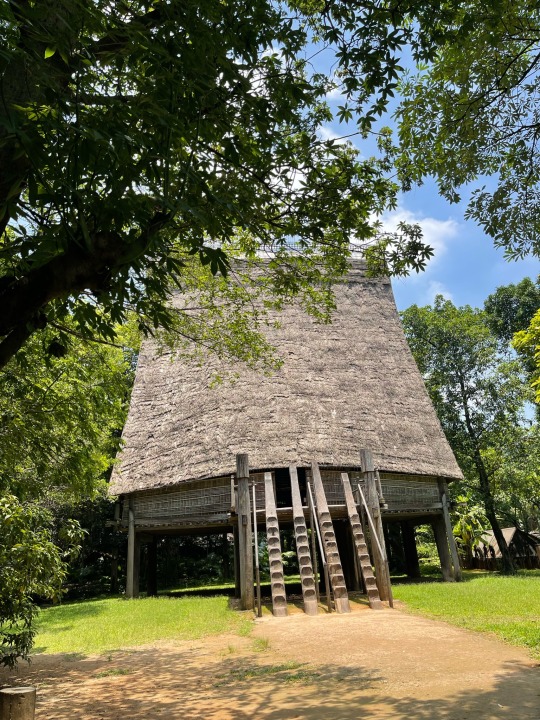




Maison commune ethnie des bahnar… il y a 56 Ethnies différentes au Vietnam, avec leurs coutumes propres…
1 note
·
View note
Text
Wie geht es mit der Wohnbebauung am alten Bahnareal weiter?
Wie geht es mit der Wohnbebauung am alten Bahnareal weiter?
Augsburg: „…Ein neuer Projektentwickler tritt auf den Plan. Öffentlich schweigt das Unternehmen noch zu seinen Plänen am Bahnareal im Hochfeld. Doch hinter den Kulissen gab es einen Vorstoß.
Die Grundstücke südlich des historischen Bahnparks im Hochfeld sind durch einige Hände gegangen. Nun tritt ein neues großes Immobilienunternehmen an, das auf dem innerstädtischen Gelände bauen will. Es ist…

View On WordPress
#Augsburg#Bahnareal#Bauverwaltung#Gelände#Grundstücke#Hochfeld#Immobilienunternehmen#Kulissen#Plan#Wohnbebauung
0 notes
Link
Sở dĩ gạo Ba Chăm vẫn luôn được gọi là ‘hạt ngọc trời’ vì đây là giống lúa quý, được người dân tộc Bahnar canh tác theo phương thức truyền thống, hoàn toàn dựa vào tự nhiên.
0 notes
Text
Insight into Kachok (/kəcɑʔ/)
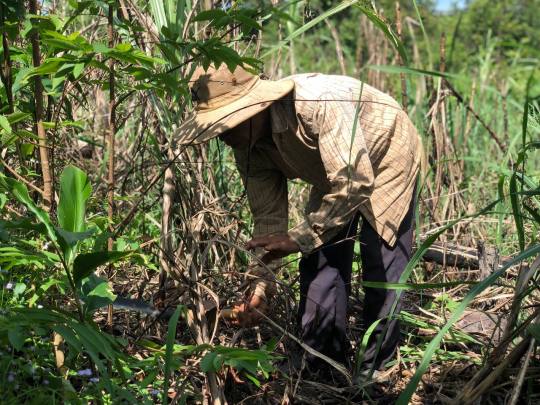
[Image description: A photo of a Kachok man working in a field. /End ID]
What is the language called in English and the language itself?
– It’s called Kachok or Kaco’ in English and Kaco’ in the language itself.
– There are two dialect of Kachok: Kaco’ and Romam.
Where is the language spoken?
– Kachok is spoken in and around the Mo Rai commune of the Kon Tum province in Vietnam. The Romam dialect is spoken mainly in Le village.
How many people speak the language?
– There are between 250 and 3,600 speakers of Kachok. An accurate census in impossible to achieve.
Which language family does it belong to? What are some of its relative languages?
– Kachok is classified as Austroasiatic > Bahnaric > Northern > Sedang–Todrah > Kachok. Its closest relative language is Lamam, but it’s also related to Sedang and Hrê among others.
What writing system does the language use?
– It uses the Latin script, though it is mostly spoken.
– Sample texts from Olsen, 2018: ʔaj çə-hjen o ceh məj. | ʔaj çə-nam o pɑ panluŋ. | ʔaj kə-lɑʔ poŋ məto. | pʰɑj ceh məj ʔaj kə-lɑʔ o hjen. | ʔaj ceh kap mɑ̃ klaw ʔaɪ. | ncɑl ʔaj nam pɑ tʰe̤ kəcut ʔaj kə- lɑʔ kap kəcɑ̤ʔ.
What kind of grammatical features does the language have?
– Kachok is an SVO language with relatively free word order, all things considered. It has 2 tenses (past and non-past), 3 numbers (singular, dual, and plural), and 3 persons. Kachok also demonstrates post-adjectives, voice quality, and (C)(V)XVC syllable structure.
What does the language sound like?

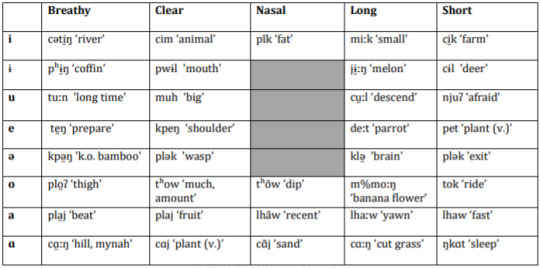
What do you personally find interesting about the language?
– Interestingly enough, the Kachok language is thriving in its community despite being endangered. That is rarely the case for endangered languages, but Kachok is spoken fluently by most all Kachok people. I was happy to hear that.
1 note
·
View note
Text
0 notes
Text
Introduction to linguistics
Language relations
Language families
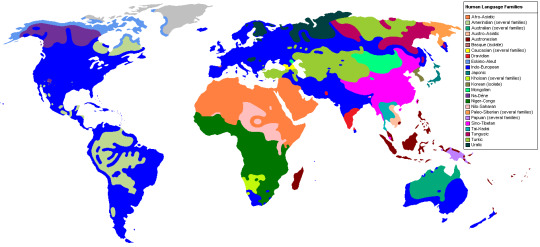
Just like living organisms, languages evolve, and the ones that come from the same ancestor (called “proto-language”) are part of the same language family. A language family can be subdivided into several subfamilies.
Comparative linguistics compares languages in order to establish their historical relatedness. This can be done by comparing their phonology, grammar, and vocabulary, even in cases where there are no written accounts of their ancestors.
The farther languages are from each other, the more difficult it can be to determine if there is a genetic relationship between them. For example, no linguist doubts that Spanish and Italian are related, but the existence of the Altaic family (which would include Turkish and Mongolian) is controversial and not accepted by all linguists. At present, it is simply impossible to know if all languages come from a common ancestor. If an original human language did exist, it would have been spoken tens of thousands of years ago. This makes comparisons extremely difficult or even impossible to perform.
Linguists have identified more than a hundred primary language families, i.e., language families that are not known to be related to each other. Some of them include only a few languages, others more than a thousand. Here are some of the main language families of the world:
Afro-Asiatic (Middle East, North Africa): Amazigh languages (Kabyle, Tamasheq, Zenaga...), Chadic languages (Hausa, Musgu, Tumak...), Cushitic languages (Beja, Oromo, Somali...), Omotic languages (Chara, Hozo, Nayi...), and Semitic languages (Amharic, Arabic, Hebrew...).
Altaic* (Turkey to Siberia): Mongolic languages (Dagur, Khamnigan, Shira Yugur...), Tungusic languages (Manchu, Oroch, Solon...), and Turkic languages (Turkish, Uyghur, Yakut...).
Austroasiatic (southeastern Asia): Aslian languages (Cheq Wong, Mah Meri, Semai...), Bahnaric languages (Alak, Laveh, Sedang...), Katuic languages (Kuy, Pacoh, Ta’Oi...), Khasi-Palaungic languages (Kiorr, Riang, War...), Khmer, Khmuic languages (O’du, Mlabri, Theen...), Mangic languages (Bolyu, Bugan, and Mang), Monic languages (Mon Rao, Mon Ro, Nyah Kur...), Munda languages (Juray, Kharia, Korku...), Nicobarese languages (Car, Nancowry, Teressa...), Pearic languages (Kasong, Somray, Suoi...), and Vietic languages (Cuói, Maleng, Vietnamese...).
Austronesian (southeastern Asia, Taiwan, Pacific, Madagascar): Atayalic languages (Atayal and Seediq), Bunun, East Formosan languages (Kavalan, Nataoran, Siraya...), Malayo-Polynesian languages (Chamorro, Javanese, Sundanese...), Northwest Foromosan languages (Pazeh, Saisiyat, and Thao), Paiwan, Puyuma, Rukai, Tsouic languages (Kanakanabu, Saaroa, and Tsou), and Western Plains languages (Babuza, Hoanya, Taokas....).
Dravidian (south India): Central Dravidian languages (Dhurwa, Kolami, Naiki...), North Dravidian languages (Brahui, Kurukh, and Malto), South-Central Dravidian languages (Chenchu, Gondi, Pengo...), and South Dravidian languages (Badaga, Malayalam, Tulu...).
Indo-European (Europe to India, nowadays all the continents): Albanian, Armenian, Balto-Slavic languages (Latvian, Polish, Russian...), Celtic languages (Breton, Irish, Scottish Gaelic...), Germanic languages (Danish, English, German...), Greek, Indo-Iranian languages (Bengali, Kamkata-vari, Kurdish...), and Italic languages (French, Italian, Portuguese...).
Kartvelian languages (South Caucasus): Georgian-Zan languages (Georgian, Laz, and Mingrelian) and Svan.
Kra-Dai (southeastern Asia): Be, Biao, Hlai languages (Cun, Qi, Run...), Kam-Sui languages (Mak, Mulam, Then...), Kra languages (Lachi, Laha, Qabiao...), Lakkia, and Tai languages (Bouyei, Lao, Shan...).
Na-Dene (North America): Tlingit and Athabaskan-Eyak languages (Ahtna, Hupa, Navajo...).
Niger-Congo (Sub-Saharan Africa): Atlantic-Congo languages (Bariba, Lingala, Yoruba...), Bangime, Dogon languages (Dogul, Jam Sai, Tebul...), Ijaw languages (Izon, Kalabari, Oruma...), Katla languages (Domorik and Kaalak), Mande languages (Goo, Loma, Soninke...), Rashad languages (Tagoi and Tegali), Siamou, Talodi-Heiban languages (Logol, Moro, Tocho...).
Northeast Caucasian languages (Caucasus): Avar-Andic languages (Andi, Avar, Bagvalal...), Dargic languages (Chirag, Itsari, Kajtak...), Khinalug, Lak, Lezgic languages (Aghul, Archi, Rutul...), Nakh languages (Bats, Chechen, and Ingush), and Tsezic languages (Bezhta, Hinukh, Khwarshi...).
Northwest Caucasian languages (northwestern Caucasus): Abazgi languages (Abaza and Abkhaz) and Circassian languages (Adyghe and Kabardian).
Sino-Tibetan (Asia): Bai, Bodo-Garo languages (Atong, Bodo, Megam...), Jingpho-Luish languages (Ganan, Jingpho, Sak...), Karenic languages (Pa’o, Pwo, Sgaw...), Kuki-Chin languages (Falam, Mro, Thaiphum...), Lolo-Burmese languages (Gong, Mru, Naxi...), Meitei, Sinitic languages (Caijia, Hokkien, Taihu Wu...), Tamangic languages (Chantyal, Gurung, Kutang...), and Tibetic languages (Balti, Dzongkha, Sikkimese...).
Tupian (South America): Arikem languages (Arikem, Kabixiana, and Karitiâna), Awetï, Mawé, Monde languages (Aruáshi, Gavião do Jiparan, Suruí...), Mundurukú languages (Kuruáya and Munduruku), Puruborá-Ramarama languages (Karo, Puruborá, and Urumi), Tuparí languages (Makuráp, Mekéns, Tuparí...), Tupi-Guaraní languages (Guajá, Sirionó, Tapirapé...), and Yurúna languages (Jurúna, Maritsauá, and Xipaya).
Uralic (central, eastern, and northern Europe, northern Asia): Finno-Permic languages (Komi, Livonian, Ume Sámi...), Hungarian, Khanty, Mansi, and Samoyedic languages (Enets, Nganasan, Selkup...).
*Some linguistics claim that the similarities found between subfamilies are due to borrowings or chance and not due to a genetic connection between them.
I have chosen three languages from different branches as examples for each subfamily, but of course, in most cases, there are many more. Some languages have several names, so I have used the most common one.
Language isolates
A language isolate is a language that has not been proven to belong to a known language family. The best example is Basque, spoken in Spain and France. Even though it is surrounded by Indo-European languages, it is very different from them. Linguists have compared Basque and other languages spoken in Europe, the Caucasus, and even America, but no relationship has ever been demonstrated.
Korean is another well-known isolate, although some linguists have proposed a relationship with the Altaic languages or Japanese. Japanese itself is sometimes considered an isolate, but it is best described as belonging to the small Japonic family, which includes a few related languages such as Okinawan.
239 notes
·
View notes
Text
ethnic regions of the world(part 1)
Abazinia(Russia)-Abazins
Aceh(Indonesia)-Acehnese
Edo state(Nigeria)-Afemai
Assam(India)-Ahom, Chutiya
Dabou(Ivory Coast)-Adjoukrou
Gold Coast(Ghana)-Akan
Ambon Island(Indonesia)-Ambonese
Amharia(Ethiiopia)-Amhara
Akwa Ibom State(Nigeria)-Anaang
Apacheria (United States)-Apache
Kaduna State (South Sudan)-Atyap
Dagestan (Russia)-Avars, Dargins
Awadh (India)-Awadhis
Central Highlands (Vietnam)-Bahnar
Dali Bai Autonomous Prefecture (China)-Bai
Bakossi Mountains (Cameroon)-Bakossi
Bali (Indonesia)-Balinese
Kabardino-Balkaria (Russia)-Balkars
Gilgit-Baltistan (Pakistan)-Balti
Cameroon (West and Northwest Regions)-Bamileke
West Region (Cameroon)-Bamum
South Kalimantan (Indonesia)-Banjarese
Bassaland (Liberia)-Bassa
Bashkortostan (Russia)-Bashkirs
North Sumatra (Indonesia)-Batak
Plateau State(Nigeria)-Berom
Jakarta(Indonesia)-Betawis
Bicol Region(Philippines)-Bicolanos
Sarawak(Malaysia)-Bidayuh
Lake Fitri (Chad)-Bilala
Soccsksargen (Philippines)-Blaan
Bas-Uele (Democratic Republic of the Congo)-Boa
Bodoland (India)-Bodo
Guizhou (China)-Bouyei
Balochistan (Pakistan)-Brahuis
Brittany (France)-Bretons
Wamba Territory (Democratic Republic of the Congo)-Budus
South Sulawesi (Indonesia)-Buginese
Gilgit-Baltistan (Pakistan)-Burusho
Buton (Indonesia)-Butonese
Mariana Islands (United States)-Chamorro
Chechnya (Russia)-Chechens
Chuuk Lagoon (Federated States of Micronesia)-Chuukese
Chuvashia (Russia)-Chuvash
Circassia (Russia)-Circassians
Chittagong Hill Tracts (Bangladesh)-Chakmas
Cornwall (United Kingdom)-Cornish
Corsica (France)-Corsicans
Cuyo Archipelago (Philippines)-Cuyunon
Kingdom of Dagbon (Ghana)-Dagombas
Damaraland (Namibia)-Damara
Deccan (South-Central India)-Deccani
Bandiagara Escarpment (Mali)-Dogon
Jammu Division (India)-Dogra
Gujarat(India)-Dubla, Gujarati
3 notes
·
View notes
Text
Got asked about examples of initial consonant cluster reduction, and after going through Germanic (English wr- wl- kn- > r- l- n-; most of Germanic hr- hl- hn- > r- l- n-), Lhasa Tibetan (Pr- > Ʈ-, zl- ld- > nd-, brgy- > ɟ-, etc.), Vietnamese (ml- > ɲ-, which is the only one I remember off the top of my head), and Romance (Latin stl- > l-; ) I got “most of these changes seem to require a glide”, and apparently the answer to that is Nyaheun, a Bahnaric language that underwent complete monosyllabization, mostly through the processes of initial geminate formation and lenition of an initial after a preinitial: (Proto-Bahnaric > Nyaheun)
*cna: > n:a:
*ɟrla: > l:a:
*Cto:ɲ > t:o:ɲ
*cŋa:j > ŋja:j
*kta:m > gra:m
*tpal > dwaw
*tŋaj > nɨe, ŋ̊eː
IIRC, Vietnamese also had lenition of an initial after a preinitial, and Baxter and Sagart reconstruct something like this for Old Chinese > Min.
(Where did Proto-Micronesian initial geminates come from?)
15 notes
·
View notes
Quote
Theo Hoàng Lê Nhất Thống Chí của Ngô Gia Văn Phái, danh xưng “mọi” xuất hiện từ thế kỷ 18 khi Nguyễn Huệ mang quân ra Bắc phò Lê diệt Trịnh. Triều thần nhà Lê (Trương Tuân và Dương Trọng Tế) thời đó gọi quân Tây Sơn là quân Mọi. Sở dĩ có tên gọi này vì quân Tây Sơn đa số là người Thượng (đảm trách phần nhiệm tải người và vật dụng), kẻ nào cũng lưng đóng khố, tay cầm đòn ống, mình trần trùng trục. Chưởng Tiến, một lục lâm hảo hán thời đó, mắng quân Tây Sơn là lũ Hồng Mao, mọi lông đỏ vì trên đầu mỗi binh sĩ đều vấn vải đỏ và giắt lông chim (một phong tục của người Bahnar khi lâm trận).
Cộng đồng người Thượng trên cao nguyên miền Trung
17 notes
·
View notes